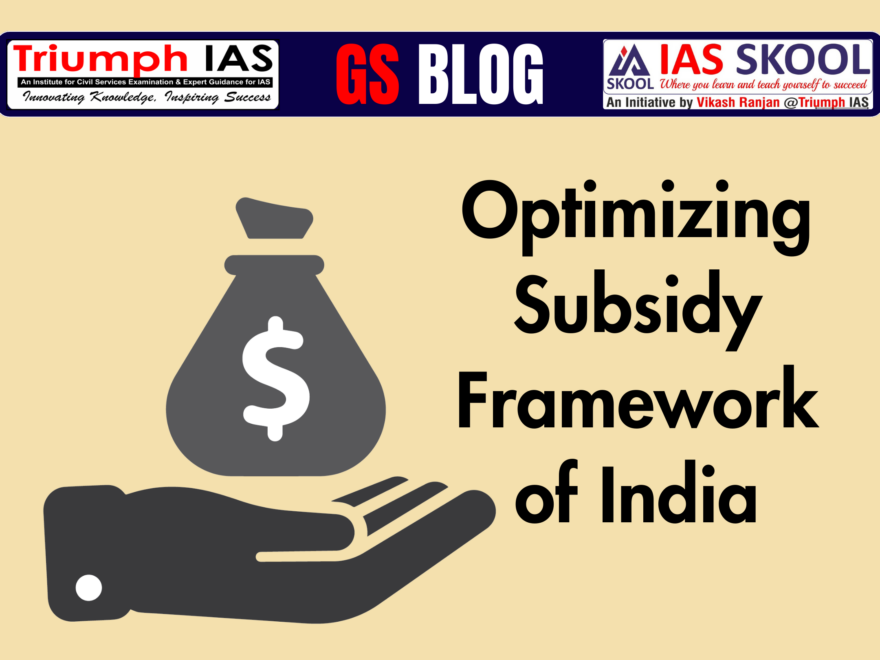Optimizing Subsidy Framework of India
India’s subsidy framework has seen substantial reforms, including the deregulation of fuel prices, rationalization of LPG subsidies, and the integration of technology for efficient delivery. Despite these advancements, challenges remain, such as inefficiencies in targeting food subsidies under the Pradhan Mantri Garib Kalyan Anna Yojana and the stagnation of fertilizer MRPs despite rising production costs. Explicit subsidies have reduced from 12.7% of the budget in FY23 to 9.3% in FY24. Further rationalization to below 1% of GDP necessitates targeted interventions that maintain support for genuine beneficiaries.
Subsidies
Subsidies refer to financial aid or incentives offered by the government to individuals, businesses, or specific sectors to foster public welfare, drive economic growth, and ensure social equity.
They are designed to lower the cost of goods and services, assist vulnerable groups, and encourage activities that align with national objectives, such as boosting agricultural output, promoting renewable energy, and supporting industrial growth.
Subsidies can be provided directly (cash transfers) or indirectly (tax exemptions or price controls).
Major Advantages of Government Subsidies in Promoting Development and Ensuring Equity
Ensuring Food Security and Reducing Hunger:
Government subsidies on essential food items play a pivotal role in ensuring access to affordable nutrition for vulnerable sections of society.
- Subsidized grains provided under schemes like the Public Distribution System (PDS) and Pradhan Mantri Garib Kalyan Anna Yojana (PMGKAY) significantly mitigated hunger during crises like COVID-19.
- For instance, 810 million beneficiaries receive free grains under PMGKAY. The government has allocated ₹2.25 lakh crore for food subsidies in FY25, reflecting its commitment to food security amidst global inflation and supply chain disruptions.
Supporting Farmers and Boosting Agricultural Productivity:
Subsidies on fertilizers, irrigation, and power make essential inputs more affordable, ensuring profitability and productivity for farmers.
- In response to rising fertilizer costs, the government doubled subsidies in 2022, shielding farmers from inflation.
- The special subsidy of ₹3,500 per tonne on di-ammonium phosphate (DAP) was extended through 2025.
- Under the Pradhan Mantri Krishi Sinchayee Yojana – Per Drop More Crop scheme, financial assistance of 55% for small farmers and 45% for others helps improve irrigation practices.
Promoting Clean Energy and Sustainability:
Renewable energy subsidies encourage a shift to sustainable practices, reducing dependence on fossil fuels.
- The Pradhan Mantri Kisan Urja Suraksha evam Utthan Mahabhiyan (PM-KUSUM) subsidizes solar pumps, reducing diesel use and groundwater depletion while curbing carbon emissions.
Enhancing Access to Healthcare and Social Security:
Healthcare subsidies ensure affordable medical services for economically weaker sections, reducing financial burdens.
- Ayushman Bharat – Pradhan Mantri Jan Arogya Yojana, the world’s largest health assurance program, covers ₹5,00,000 annually per family, benefiting over 50 crore individuals in the bottom 40%.
Reducing Inequality through Welfare Programs:
Targeted subsidies help bridge disparities, ensuring access to basic services for marginalized groups.
- LPG subsidies under Pradhan Mantri Ujjwala Yojana (PMUY) provided clean cooking fuel to over 9.6 crore households, significantly improving women’s health and promoting gender equity.
- Stabilized LPG prices since March 2024 have increased refill rates to 4 per year for Ujjwala beneficiaries.
Driving Industrial Growth and Employment:
Subsidies in manufacturing and MSMEs stimulate production, create jobs, and enhance global competitiveness.
- The Production-Linked Incentive (PLI) Scheme, with ₹1.97 lakh crore across 14 sectors, has generated over 60 lakh jobs and bolstered GDP growth.
- India’s smartphone exports exceeded $2 billion in October 2024, driven by PLI incentives.
Addressing Climate Change and Environmental Concerns:
Environmental subsidies promote sustainable alternatives and reduce reliance on harmful practices.
- The Faster Adoption and Manufacturing of Hybrid and Electric Vehicles (FAME-II) scheme supported the sale of 1.67 million EVs in FY24, reducing CO₂ emissions.
- Subsidies under programs like Namami Gange improved river health and groundwater recharge, fostering environmental sustainability.
Investing in Education and Skill Development:
Educational subsidies improve access for underprivileged students, fostering long-term economic growth.
- Programs like PM Poshan (Midday Meal) and scholarships for SC/ST students have increased enrollment and retention rates, particularly among girls.
- The gross enrollment ratio in higher education has risen to 28.3%.
Empowering Women and Marginalized Communities:
Targeted subsidies promote inclusivity and gender equality.
- Stand-Up India subsidies have supported over 1.8 lakh women entrepreneurs, providing affordable credit and capacity building.
- Maternal healthcare under Janani Suraksha Yojana reduced maternal mortality rates from 130 per lakh live births in 2014 to 97 in 2018-20.
- Bridging the Digital Divide and Driving Inclusion:
Subsidies in the digital sector enhance technology access in underserved regions, fostering financial inclusion.
- The PM-WANI scheme subsidizes Wi-Fi hotspots, expanding connectivity in rural and semi-urban areas.
- Subsidies and incentives for small merchants have strengthened India’s digital payment ecosystem, with UPI transactions reaching ₹23.25 lakh crore in December 2024

Key Challenges Associated with Government Subsidies
Fiscal Strain and Resource Misallocation:
Government subsidies place a significant burden on public finances, often diverting resources from vital sectors like health, education, and infrastructure.
- In FY25, the government is projected to spend approximately ₹4.1–4.2 lakh crore on major subsidies, with food subsidies being the largest component.
- Meanwhile, public health spending remains stagnant at just 1.84% of GDP, far below the global average of 6%.
Poor Targeting and Ghost Beneficiaries:
Subsidies often fail to effectively reach the intended beneficiaries due to inefficiencies, inclusion errors, and leakages.
- Under the National Food Security Act, 2013 (NFSA), up to 75% of the rural and 50% of the urban population are targeted, yet many undeserving beneficiaries are included.
- Over 40% of subsidized rice and wheat meant for distribution through fair-price shops (FPS) is diverted to open markets, and similar issues affect LPG subsidies under the Ujjwala Yojana due to poor last-mile delivery.
- Former PM Rajiv Gandhi once noted that only 15 paise of every rupee spent by the government reaches the intended beneficiaries.
Encouraging Overuse and Resource Depletion:
Subsidized electricity and fertilizers often lead to overuse, depleting natural resources and causing environmental degradation.
- Free electricity for irrigation has accelerated groundwater over-extraction, with 230 billion cubic meters drawn annually for agricultural use, according to the Central Ground Water Board (CGWB).
- Excessive fertilizer use, supported by subsidies, has caused soil nutrient imbalances and environmental damage, with agriculture contributing 18% of India’s greenhouse gas emissions.
Market Distortions and Private Sector Disincentives:
Subsidies artificially lower costs, distorting markets and discouraging competition, innovation, and private investment.
- The ₹1.75 lakh crore fertilizer subsidy (Budget 2024-25) has disincentivized the adoption of organic and biofertilizers.
- Similarly, heavy LPG subsidies under Ujjwala have reduced the viability of alternatives like biogas, hindering market diversification.
Lack of Transparency and Delayed Payments:
Subsidies often lack proper transparency and accounting, leading to delays in fund disbursement and fiscal liabilities.
- For instance, the Food Corporation of India (FCI) accumulated ₹1.18 lakh crore in debt with the National Small Savings Fund (NSSF) for food subsidy payments before it was cleared in 2021.
- Such delays undermine fiscal discipline and increase the government’s interest burden.
Global Trade Challenges and WTO Criticism:
Government subsidies frequently face scrutiny in global trade forums, leading to disputes and reputational risks.
- India’s $48 billion farm input subsidies in 2022-23 attracted criticism from WTO members like the US, EU, and Canada for allegedly distorting trade and breaching Aggregate Measurement of Support (AMS) norms.
Populism and Electoral Motivations:
Subsidies are often used as populist tools for electoral gains, resulting in unsustainable policies and delayed reforms.
- The culture of promising freebies, such as free electricity, undermines fiscal sustainability.
- For example, the annual electricity cost of providing free power to the agricultural sector has exceeded ₹6,500 crore but persists due to political compulsions.
- Subsidies sometimes foster dependence, discouraging beneficiaries from achieving self-sufficiency or productivity improvements.
Weak Incentives for Innovation:
Subsidies often fail to encourage innovation or the adoption of modern technologies, perpetuating inefficiencies.
- Despite the introduction of nano urea as a sustainable alternative, traditional urea remains heavily subsidized, discouraging farmers from transitioning.
- Delays in implementing fertilizer Direct Benefit Transfer (DBT) systems and limited awareness of advanced irrigation techniques hinder technological advancements in agriculture.
Can India Rationalize its Subsidy System for Greater Efficiency?
Comprehensive Implementation of Direct Benefit Transfer (DBT):
Transitioning fully to DBT can ensure subsidies directly reach intended beneficiaries, reducing inefficiencies and leakages.
- The successful implementation of DBT in LPG through the PAHAL scheme showcases its potential. Extending DBT to fertilizer subsidies could minimize misuse and ensure support reaches genuine farmers.
- Linking DBT with Aadhaar and incorporating real-time digital monitoring can enhance transparency and accountability.
- The Shanta Kumar Committee has advocated for shifting from grain-based distribution to cash transfers to improve efficiency and reduce wastage.
Dynamic Targeting Using Updated Data:
Periodic revision of beneficiary lists based on dynamic poverty and consumption data, such as the Socio-Economic and Caste Census (SECC), ensures better targeting.
- Leveraging advanced analytics and AI-driven data verification can refine beneficiary selection, ensuring subsidies benefit the most deserving populations.
- These measures align with the recommendations of the Expenditure Management Commission (2014) to rationalize subsidies based on targeted needs.
Promoting Sustainable Alternatives:
Encouraging the adoption of eco-friendly technologies like nano urea and organic fertilizers can reduce dependency on traditional subsidies.
- Nano urea alone can save ₹10,000–₹15,000 crore annually while mitigating environmental harm.
- NITI Aayog has proposed targeted subsidies for liquid fertilizers to promote fertigation under micro-irrigation systems.
- Linking solar-powered irrigation under PM-KUSUM with fertilizer DBT schemes could reduce electricity subsidies and encourage sustainable energy use.
- The Kelkar Committee (2012) emphasized curbing unnecessary expenditure on fuel, food, and fertilizer subsidies.
Integrating Technology for Monitoring and Accountability:
Advanced technologies such as GIS and blockchain can enhance subsidy distribution efficiency and transparency.
- GIS mapping ensures subsidies like fertilizers are allocated to actual cultivators, preventing diversion.
- Blockchain technology can strengthen transparency in the Public Distribution System (PDS), ensuring benefits reach the right recipients.
Aligning Subsidies with Environmental Goals:
Reforming subsidies to align with sustainability objectives is essential.
- Replacing free electricity for irrigation with metered, time-bound electricity can address groundwater depletion caused by over-extraction.
- Redirecting fossil fuel subsidies to renewable energy initiatives supports India’s transition to a greener energy future.
Behavioral Change Campaigns Linked to Subsidies:
Combining subsidies with awareness programs can encourage long-term sustainable practices.
- Integrating Ujjwala with PM Poshan (Midday Meal Scheme) could promote clean cooking practices for better health outcomes.
- Linking fertilizer subsidies with the Soil Health Card Scheme can encourage scientific nutrient management and reduce environmental damage.
Fostering Public-Private Partnerships (PPPs):
Encouraging PPPs can improve subsidy delivery and resource utilization.
- Collaboration with fertilizer companies to promote nano fertilizers and enhance distribution networks can increase efficiency.
- PPPs can also develop infrastructure for e-PoS systems in rural areas, improving the delivery of food and LPG subsidies.
Reforming Agricultural Subsidies with Crop Diversification:
Linking subsidies to sustainable farming practices can encourage crop diversification.
- Providing MSP incentives for pulses and oilseeds instead of water-intensive crops like rice and wheat can conserve resources.
- Overstocking of rice (4x the buffer norms) highlights the need for better resource management.
- Incentives under the Mission for Integrated Development of Horticulture (MIDH) can promote horticulture, enhance farmer incomes, and reduce environmental stress.
Subsidy Credit System Based on Performance:
Introducing a credit system where beneficiaries earn subsidies based on responsible usage and sustainable practices can reduce waste.
- Farmers adopting micro-irrigation or reducing fertilizer overuse (verified via soil health data) could earn additional subsidies.
- Ujjwala LPG subsidies could depend on consistent refill usage, encouraging long-term adoption.
- Linking these credits to a Unified Subsidy Wallet (Aadhaar-linked) can streamline implementation.
Conclusion:
Rationalizing India’s subsidy system through targeted delivery, technological integration, sustainable practices, and gradual reforms can enhance efficiency while ensuring support for the most vulnerable sections of society
The End of the Blog: Optimizing Subsidy Framework of India

|



















One comment